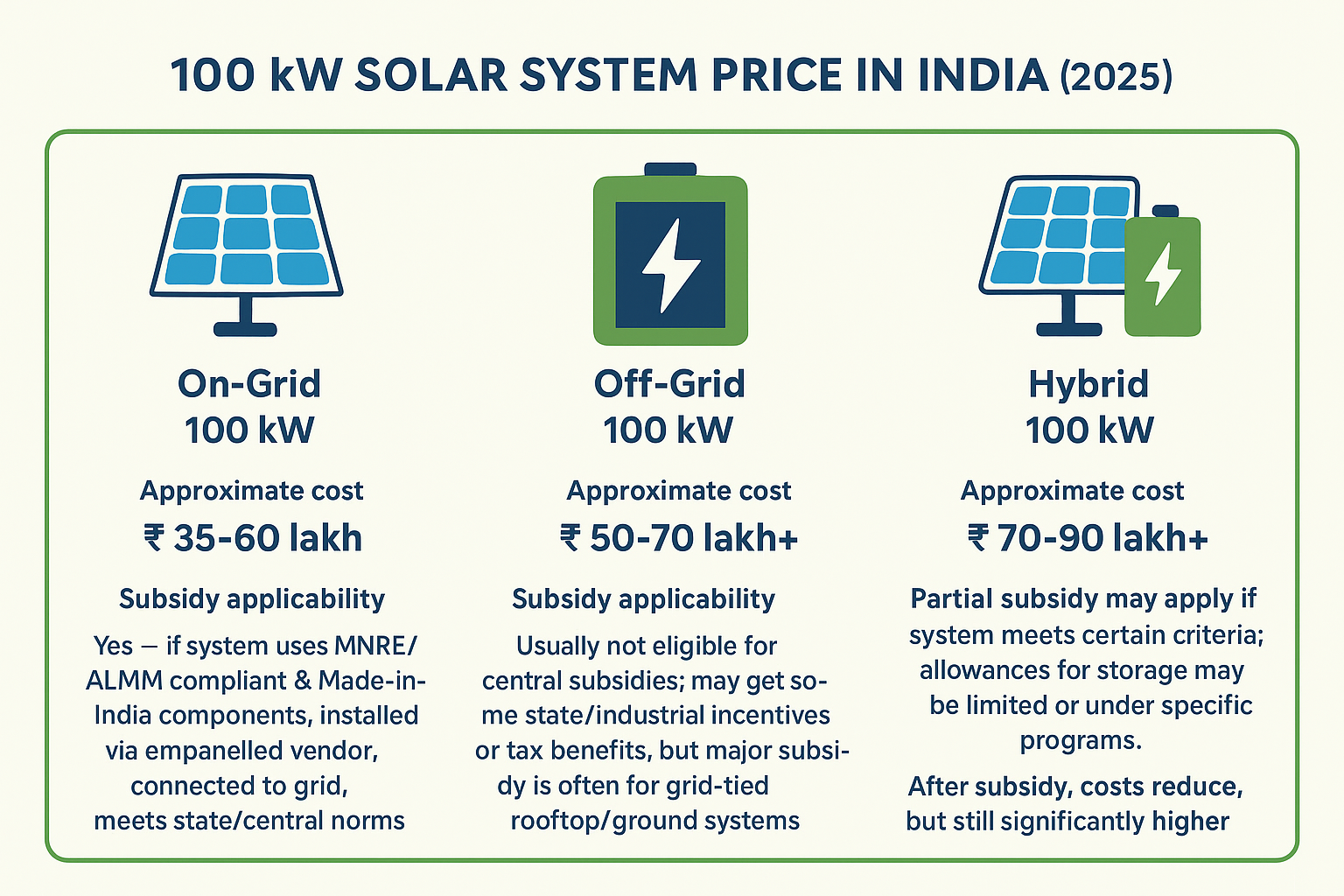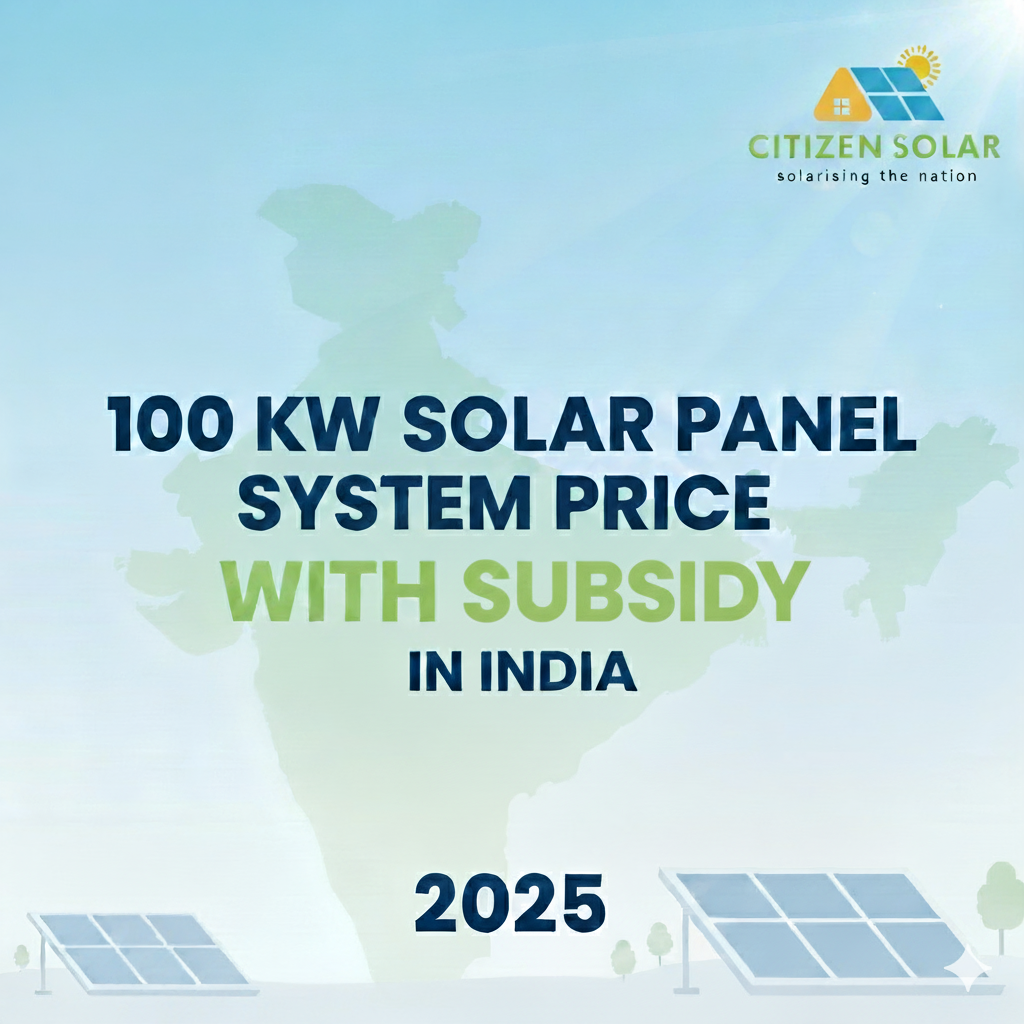As India continues its transition toward renewable energy, solar power has become one of the most reliable and cost-effective solutions for businesses, industries, and housing societies. Among different system sizes, the 100 kW solar panel system stands out as an ideal choice for large-scale energy consumers who want to reduce their dependency on the grid and cut electricity costs.
In 2025, the demand for 100 kW solar systems is expected to grow rapidly due to falling panel prices, improved efficiency, and supportive government policies. With subsidies, tax incentives, and net-metering benefits, investing in solar is more affordable than ever before. A 100 kW solar system can not only deliver significant long-term savings but also contribute to sustainability goals by reducing carbon emissions.
In this guide, we’ll cover everything you need to know about the 100 kW solar system price in India (2025), including cost estimates, subsidy details, specifications, space requirements, ROI, and frequently asked questions.
What is a 100 kW Solar System & Why It’s Beneficial
A 100 kW solar panel system is a large-scale solar installation, typically used by commercial, institutional, industrial, or large housing society setups. It can generate enough electricity to significantly reduce/offset high energy bills, stabilize energy costs, and increase self-reliance.
How It Works
- Solar panels convert sunlight (photons) into direct current (DC) via the photovoltaic (PV) effect.
- An inverter converts DC to alternating current (AC), which is usable in buildings and compatible with a grid supply.
- In on-grid systems, excess electricity is exported to the grid via net metering.
- In off-grid or hybrid setups, batteries are included to store power for use when solar generation is low or during grid outages.
Key Benefits
- Major savings on electricity bills over the long term.
- Revenue or credit on surplus power exported to the grid (where permitted).
- Lower carbon footprint; reduced environmental impact.
- Possible tax incentives, subsidies, and depreciation advantages for businesses.
Price Estimate & Specification for 100 kW Solar System (India, 2025)

Below is an estimated cost snapshot of various types of 100 kW systems (on-grid, off-grid, hybrid), and what to expect in terms of output, subsidy, and net cost.
System Type | Approximate Cost Before Subsidy* | Applicability of Subsidy / Incentives | Approximate Cost After Subsidy* |
On-Grid 100 kW | ₹ 35-60 lakh (varies by quality, region, component specs) | Yes — if the system uses MNRE / ALMM compliant & Made-in-India components, installed via an empanelled vendor, connected to the grid, and meets state/central norms. | ~ ₹ (35-60 lakh minus subsidy amount). Exact depends on subsidy scheme eligibility. |
Off-Grid 100 kW | Slightly higher base cost due to battery storage; could be ₹ 50-70 lakh+ depending on battery size & backup hours. | Usually not eligible for central subsidies; may get some state/industrial incentives or tax benefits, but a major subsidy is often for grid-tied rooftop/ground systems. | Essentially close to pre-subsidy cost (minus any smaller/local incentives) because the central subsidy typically does not apply. |
Hybrid 100 kW (with Battery + Grid Connection) | Highest cost among the types — could go up to ₹ 70-90 lakh+, depending on battery storage capacity, redundancy, and site conditions. | Partial subsidy may apply if the system meets certain criteria; allowances for storage may be limited or under specific programs. | After the subsidy, costs reduce, but are still significantly higher than on-grid systems without storage. |
*Notes: “lakh” = 1,00,000 INR. All numbers are indicative; actual prices depend heavily on location, vendor, component quality, site conditions, taxes, permits, etc.
Key Specifications & What Affects Cost
- Panels: Efficiency, type (mono, poly, bifacial, etc.), warranty.
- Inverter: Size, quality, MPPT features, voltage, efficiency.
- Mounting / Structure: Rooftop vs ground mounting; tilt, orientation.
- Balance of System: Cabling, wiring, fuses, monitoring, safety gear.
- Labour & Installation: Access, permits, roof conditions.
- Battery Storage (if off-grid or hybrid): type (Li-ion / lead acid), capacity (kWh), backup hours.
Energy Output & Space Requirement
- A well-designed 100 kW system in a decent solar-insolation area might generate anywhere from 400-600 kWh/day (depending on sun hours, shading, tilt, etc.), translating to ~120,000-180,000 kWh/year.
- Space required: For panels of ~400-450 W, this might be roughly 600-900 sq. m (or more), depending on layout, spacing, roof structure, etc.
Subsidy / Incentives in India (2025) & Eligibility
- The Central Government (MNRE) provides Central Financial Assistance (CFA) or subsidies primarily for rooftop solar systems. To get subsidy, components must comply with Indian standards (MNRE, ALMM), the system must be connected to the grid (for on-grid), and the vendor must be empanelled.
- For large commercial/industrial systems (100 kW), subsidy eligibility depends on whether state/central schemes include such capacity. Some schemes may restrict subsidy to smaller capacities (residential, rooftop up to certain limits).
- Applications are usually done via the national rooftop solar portal (e.g., PM Surya Ghar / equivalent) or via DISCOM / local nodal agency.
Cost After Subsidy: Example Calculation
Here’s a simplified example (hypothetical) to illustrate how a subsidy could reduce the net cost.
- Suppose an on-grid 100 kW system costs ₹ 50,00,000 before subsidy.
- If eligible for a subsidy of, say, ₹ 2,00,000 under a given scheme (depending on component criteria), then net cost = ₹ 48,00,000.
- If additionally there are state-level incentives, tax deductions, or depreciation benefits, further cost savings may apply.
Frequently Asked Questions (for 100 kW Systems)
1. How many units (kWh) will a 100 kW system produce per day / per year?
Depends on sunlight hours, efficiency, shading, etc. On a good rooftop, you might get ~4-6 peak sun hours → ~ 400-600 kWh/day. Annually, maybe ~120,000-180,000 kWh.
2. Which system type should I choose: on-grid, off-grid, or hybrid?
- On-grid is cheapest and best if the grid is reliable and net metering permitted.
- Off-grid is useful in remote/unreliable grid areas, but cost of batteries and backups is high.
- Hybrid gives freedom & backup but at a higher cost; may make sense for critical operations or intermittent grid access.
3. How many panels are required?
If panels are 400 W each, 100,000 W ÷ 400 W ≈ 250 panels. If using higher wattage panels, fewer are required; layout and shading impact count.
4. What is required to ensure subsidy eligibility?
- Components/modules that comply with MNRE / ALMM standards.
- Vendor/installer empanelled under the national/state scheme.
- Proper documentation, grid connection (if required), and compliance with safety and installation norms.
5. What’s the payback period?
Depending on electricity tariffs, solar output, net metering, and how much of your load is served by solar, payback might be in 4-7 years (for many commercial / C&I settings). With high tariffs and good sun exposure, it may be quicker.
6. What maintenance is required?
Mostly cleaning of panels, periodic inspection of the inverter, wiring, and structure. Batteries (if used) need more maintenance. Many parts (like panels) come with 20-25 year warranties; inverters perhaps 5-10 years.
Summary & Advice
- A 100 kW solar system can be a great investment for businesses, large housing societies, factories, etc.
- Be very clear on subsidy eligibility: verify component compliance, vendor credentials, and application process.
- Get multiple quotes; check for hidden costs (transport, installation, permits, net metering approvals).
- Use good components (panels, inverters) – cheaper upfront may cost more in performance & maintenance.
- Consider hybrid or battery only if needed — cost jumps significantly with storage.

